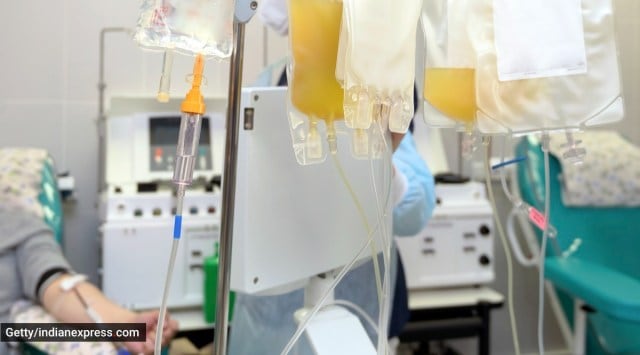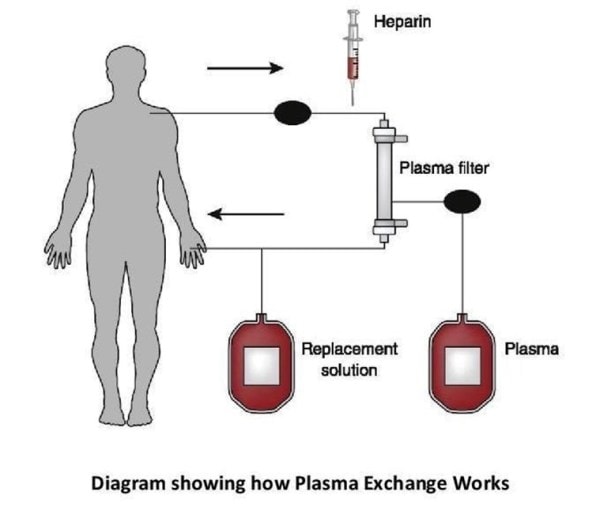📣 For more lifestyle news, click here to join our WhatsApp Channel and also follow us on Instagram
Plasma exchange at Rs 30,000 saves patient with acute liver failure who needed a transplant
While liver transplant costs Rs 30 lakh, doctors at Sir Ganga Ram Hospital, Delhi, used plasma infusion and continued Hepatitis B medication. ‘This has worked in 10 patients with severe alcoholic hepatitis, flare-up of hepatitis B and autoimmune hepatitis,' says Dr Dr Piyush Ranjan, Vice-Chairman and Senior Consultant, Department of Gastroenterology, Sir Ganga Ram Hospital, New Delhi
 Doctors at Sir Ganga Ram Hospital, New Delhi, have saved a 52-year-old man, who had no hope without a liver transplant, with plasma exchange therapies. (Representational image/Getty)
Doctors at Sir Ganga Ram Hospital, New Delhi, have saved a 52-year-old man, who had no hope without a liver transplant, with plasma exchange therapies. (Representational image/Getty) This is a piece of good news like no other. Doctors at Sir Ganga Ram Hospital, New Delhi, have saved a 52-year-old man, who had no hope without a liver transplant, with plasma exchange therapies. This procedure is not only cheaper, costing just Rs 30,000 per session compared to Rs 30 lakh for a transplant, it is safe and holds out hope for many who have to wait for a donor to live.
The man was admitted with symptoms of jaundice and altered consciousness. He further developed ascites (accumulation of fluid in the abdomen and decreased urine output, affecting the kidney). On further investigations, he was found to be hepatitis B virus positive and was diagnosed as suffering from acute chronic liver failure (ACLF).
At this juncture, doctors considered dialysis and offered an option of liver transplant as his parameters indicated a month’s probability of survival at 50 per cent.
Said Dr Piyush Ranjan, Vice-Chairman and Senior Consultant, Department of Gastroenterology, Sir Ganga Ram Hospital, “As there was no donor in the family, we offered an unusual option of plasma exchange (PLEX). We did a total of five sessions of PLEX for him. After the second session, his jaundice, renal functions and consciousness started improving. We continued other supportive therapies, the important one being anti-viral therapy. The patient was discharged after 20 days of hospitalisation in a stable condition. A one-month of follow-up showed his ascites (water in stomach) was completely resolved and his jaundice had normalised.”
 Diagram showing how plasma exchange works
Diagram showing how plasma exchange works
WHAT IS PLEX?
Plasmapheresis is increasingly being used as a bridge for liver transplant and in many cases a large proportion of these patients may recover by controlling other factors. In this patient, doctors continued treatment of Hepatitis B virus with medication. So, in this situation, PLEX acted as support to the failing liver.
PLEX is a procedure like hemodialysis where the blood is removed from the patient and the cellular components (RBC, WBC and platelet) are separated from plasma by centrifugation in the machine. The plasma is discarded and fresh plasma (FFP) and albumin is mixed along with the cellular components and returned to the patient. The old plasma contains a lot of toxic products produced by the damaged liver. Since in PLEX the entire plasma is removed, all toxic products are removed too as compared to dialysis and MARS, where the removal is limited by the pore size.
WHY PLEX IS VIABLE?
The cost of PLEX for every session is around Rs 30,000 and blood donors are required. “On an average, responsive patients undergo three sessions of PLEX infusion. Some, like our patient, may require more. In this particular patient, five sessions proved to be life-saving and provided time for other treatments to take their effect. We are regularly offering PLEX to our patients with the most common indications being failed steroid treatment for severe alcoholic hepatitis, flare-up of hepatitis B and autoimmune hepatitis. We select these patients based on well-established criteria. We have done this procedure on 10 patients with good results and saved the need for high-cost liver transplants,” said Dr Ranjan.
📣 For more lifestyle news, click here to join our WhatsApp Channel and also follow us on Instagram





- 01
- 02
- 03
- 04
- 05






















